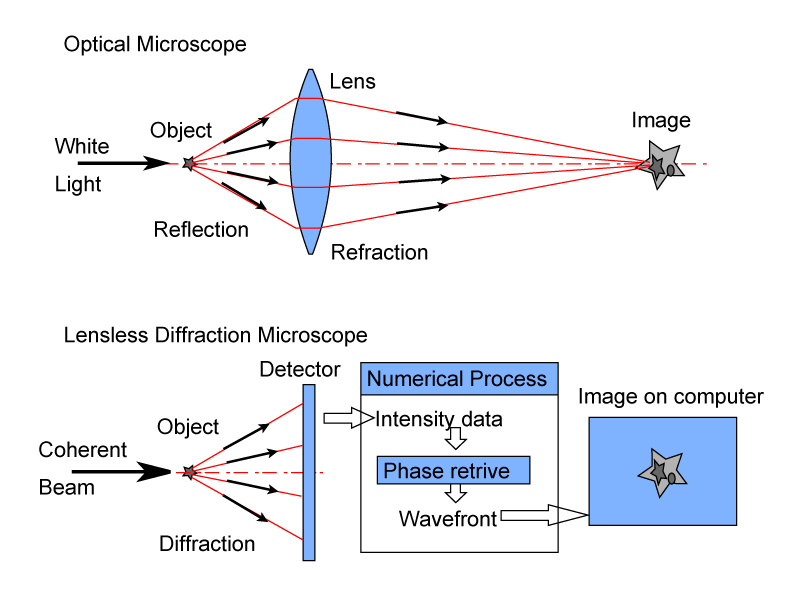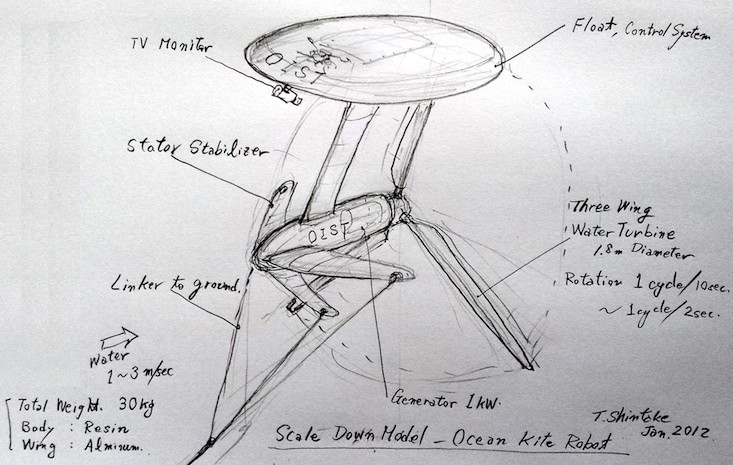FY2011 Annual Report
Quantum Wave Microscopy Unit
Dr. Katsutoshi Shirasawa, Professor Tsumoru Shintake and Reina Oshiro

Abstract
1. Electron microscope R&D on diffraction microscope, which uses quantum wave interference associated with low energy electron beam. Holographic image reconstruction and phase retrieval processes were studied on numerical simulations, and its engineering design has been started.
2. Ocean power generation R&D has been started, aiming to generate stable electric power from Kuroshio Current by using a large-scale rotating blade similar to the wind-power generator. Conceptual design work was performed.
1. Staff
- Dr. Katsutoshi Shirasawa, Researcher
- Reina Oshiro, Administrative Assistant
2. Collaborations
- Theme: Prediction of Kuroshio Current flow for ocean power generation R&D
- Type of collaboration: Joint research
- Researchers:
- Professor, Satoshi Mitarai at OIST
3. Activities and Findings
3.1 Electron Microscope Group
Conceptual Design of Electron Diffraction Microscope
In principle, by applying iterative phase retrieval on coherent diffraction data, we may determine phase on the beam, and reconstruct real image of object (Fig.1). However, this process works correctly only for 2D objects, and phase on diffraction data from 3D object can not be uniquely determined. We found we may solve this problem by introduces holographic image reconstruction. We are currently studying on in-elastic scattering electrons, and optimizing energy filter in front of the 2D diffraction detector. FIB(Focused Ion Beam) tool will be introduced in the new microscope to shape the frozen bio-samples to thin layer to allow low energy electron transmitting. Lowering electron beam energy below 1 keV, beam damages on bio-samples become vey small. We will develop the first diffraction electron microscope in FY2012, and start operation in FY2013. It will provide unique capability to view nano-size bio-particle in atomic resolution.  Figure 1: Concepts of normal optical microscope (single lens), and lensless diffraction microscope. We can totally eliminate the geometrical aberrations associated with magnetic lens, thus it will realize atomic resolution microscope.
Figure 1: Concepts of normal optical microscope (single lens), and lensless diffraction microscope. We can totally eliminate the geometrical aberrations associated with magnetic lens, thus it will realize atomic resolution microscope.
3.2 Ocean Power Generation Group
Conceptual Design of Ocean Current Power Generation
The Tōhoku earthquake and tsunami on 11 March 2011 lead the Fukushima Daiichi nuclear disaster, i.e., series of equipment failures, nuclear core meltdowns, and releases of radioactive materials. Right after this, all of nuclear plants (53 in total) in Japan have been stopped. Discussion on risk and benefit of nuclear power usage has become one of the most important subjects. No matter how the conclusion says, it is clear that we need to develop alternative energy sources in future. It has to be safe and not expensive, and friendly to natural environment.
We started R&D on "a wind farm under the ocean", which will generate Gigawatt level of stable electric power. It utilizes the ocean current instead of wind, and uses many numbers of large-scale turbines similar to the wind power generator, but floating in the water. We will utilize the strong ocean current running near the Japanese coast, named "Kuroshio". Its speed is 1 ~ 1.5 m/sec, it seems too slow, but enough to generate Gigawatt power, because the water density is 800 times higher than the air. The Kuroshio has equivalent power density as wind flow at 10~15 m/sec. The expected power output is 1 GW from 300 units of 80 m height turbines.
Figure 2 shows conceptual drawing. We use three blades design similar to wind power, while it rotates very slowly: 1~2 cycle per minute. The tip speed is slower than 30 km/h, thus large size animals (whale or dolphin) can escape from the running blades. It uses floating turbines that are anchored to the seabed by chains. The float at the top provides the lift and keeps the body stably straight by canceling the rotor torque.
We will develop scale down model in FY2012, and test its performance by towing with boat at Maeda port near to OIST. Technical design work of real size generator will be started from FY2013, followed by field test in tidal current near Okinawa.

Figure 2: Conceptual design of ocean current power generator. Real generator will be 80 m diameter.
4. Publications
Nothing to report
5. Intellectual Property Rights and Other Specific Achievements
Nothing to report
6. Meetings and Events
Nothing to report
7. Other
Nothing to report.



